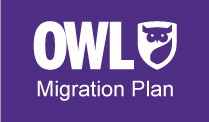Early Adopter Program
About the OWL Brightspace Early Adopter Program
The OWL Brightspace Early Adopter Project (EAP) was an opportunity for a limited number of instructors and students to fully explore OWL Brightspace, Western’s new Learning Management System (LMS), before it was available to the entire Western community in Fall 2024!
The Early Adopter Program launched on January 8 with approximately 4,700 students across 18 courses using OWL Brightspace for the Winter 2024 term. Instructors in the EAP worked closely with Western Technology Services and the Centre for Teaching and Learning to train in the new LMS, migrate course content, and set up course sites. The EAP helped develop processes and resources for OWL Brightspace for the Western community when the Academic Course Migration was launched in Fall 2024.
Why did Western have an Early Adopter Program for OWL Brightspace?
The EAP provided an opportunity for our community members to provide valuable feedback about their OWL Brightspace experience, including the identification of any areas of improvement, ahead of the full rollout.
OWL Brightspace has different tools and workflows than Western was used to with OWL Sakai. The Early Adopter Program was an important tool for helping the project team define the migration strategy and build learning resources for the Western community. It helped the OWL Migration Plan (OMP) project team better understand the resources and support systems needed for a successful transition from OWL (Sakai) to OWL Brightspace!
About the EAP Courses
21 courses were selected for the EAP by a voluntary application process. Each selected course was approved through the leadership of their faculty or unit.
18 courses were academic half-courses that ran in the January 2024 term. Of those courses, 16 were undergraduate and 2 were graduate, with an estimated enrollment of 4,700 students. The remaining 2 courses included a Western Continuing Studies course and a Human Resources course, which were included in the EAP for training purposes.
| Faculty or Affiliate | Number of Courses |
| Arts and Humanities | 2 |
| Don Wright Faculty of Music | 1 |
| Education | 2 |
| Engineering | 1 |
| Health Sciences | 2 |
| Huron University College | 1 |
| Information and Media Studies | 2 |
| King's University College | 1 |
| Schulich School of Medicine and Dentistry | 2 |
| Science | 3 |
| Social Science | 2 |
The course modalities represented in the EAP are as follows:
- Online asynchronous: 5 courses
- Online synchronous: 1 course
- Blended: 4 courses
- In-person: 10 courses
As part of the EAP, instructors and students tested key tools, features, and integrations to provide feedback on their experience. These includes:
- synchronous assessments
- question pools and banks
- lessons
- math notation
- sophisticated gradebook usage
- assignments
- team grading
- group work
- forums
- peer assessments
- LTI tools, including Gradescope, Voicethread, Zoom, Course Readings, iClicker, Research Guides, ProctorTrack, and more
Instructors and students in the EAP received dedicated support from Western Technology Services and the Centre for Teaching and Learning throughout the EAP process.
How were the courses selected?
Courses were selected through a voluntary application process in August 2023. Courses were chosen from 1000-3000 level courses across a range of disicplines, class sizes, and teaching approaches. OWL was required to be an important part of course instruction and communication to be eligible.
Courses were also required to have one or more attributes including:
- Multi-section course (multiple rosters within a single course)
- Cross-listed course
- Large synchronous assessment
- Extensive and varied/complex use of Question Banks (e.g., multiple banks, randomized questions)
- Extensive, complex use of Lessons (e.g., release conditions; variety of media; accordions and subpages; significant video content; interactive content such as polls, H5P, etc.)
- Significant and required use of math notation (e.g., in content, activities, assessments) and/or calculated questions
- Complex Gradebook (e.g., weighting, multiple columns, calculations)
- Essay courses where students submit through the Assignments tool
- Courses that use Western-supported LTI integrated tools, e.g., VoiceThread, iClicker, Gradescope, Course Readings
- Team grading (e.g., multiple people grading assignments or parts of assignments)
- Significant use of Groups and/or online groupwork and collaborative activities
- Significant use of Forum
What role did instructors play in the EAP?
We want to thank our EAP instructors for being trailblazers on this exciting initiative! Instructors in the EAP partnered with the Centre for Teaching and Learning and Western Technology Services to be the first to have a course migrated from OWL Sakai to OWL Brightspace.
They attended LMS training and explored, designed, and leveraged OWL Brightspace’s capabilities to support learning outcomes and student success with tools and processes like accessibility tools, intelligent agents, and more!
Throughout the process, they worked closely with instructional designers and the OMP project team to identify and address any unexpected issues that might arise throughout migration and during the instruction of their course. This valuable feedback helped the project team adjust key features and functionalities of OWL Brightspace ahead of wider community access. Instructor feedback from the EAP also informed the development of training resources and learning opportunities for the larger Western community.
EAP instructors shared their learning with their home faculties and units through a Community of Practice. We wanted to empower our faculty and unit champions to share their OWL Brightspace knowledge and demonstrate the power of the new LMS to their colleagues!

